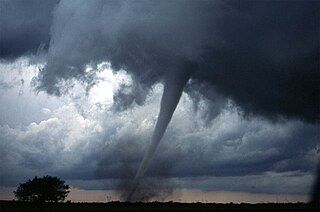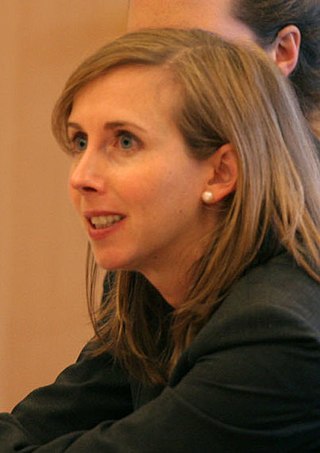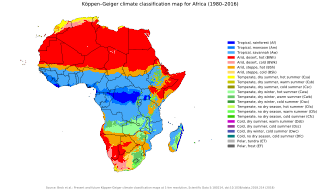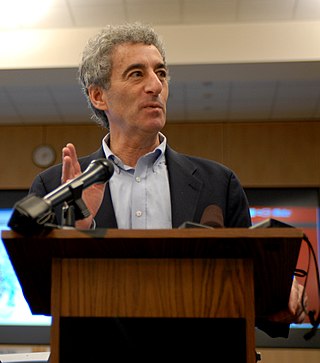Related Research Articles
Weather is the state of the atmosphere, describing for example the degree to which it is hot or cold, wet or dry, calm or stormy, clear or cloudy. On Earth, most weather phenomena occur in the lowest layer of the planet's atmosphere, the troposphere, just below the stratosphere. Weather refers to day-to-day temperature, precipitation, and other atmospheric conditions, whereas climate is the term for the averaging of atmospheric conditions over longer periods of time. When used without qualification, "weather" is generally understood to mean the weather of Earth.

Extreme weather includes unexpected, unusual, severe, or unseasonal weather; weather at the extremes of the historical distribution—the range that has been seen in the past. Extreme events are based on a location's recorded weather history. They are defined as lying in the most unusual ten percent. The main types of extreme weather include heat waves, cold waves and heavy precipitation or storm events, such as tropical cyclones. The effects of extreme weather events are economic costs, loss of human lives, droughts, floods, landslides. Severe weather is a particular type of extreme weather which poses risks to life and property.

Climatology or climate science is the scientific study of Earth's climate, typically defined as weather conditions averaged over a period of at least 30 years. Climate concerns the atmospheric condition during an extended to indefinite period of time; weather is the condition of the atmosphere during a relative brief period of time. The main topics of research are the study of climate variability, mechanisms of climate changes and modern climate change. This topic of study is regarded as part of the atmospheric sciences and a subdivision of physical geography, which is one of the Earth sciences. Climatology includes some aspects of oceanography and biogeochemistry.

A heat wave, sometimes described as extreme heat, is a period of abnormally hot weather. Definitions vary but are similar. A heat wave is usually measured relative to the usual climate in the area and to normal temperatures for the season. Temperatures that humans from a hotter climate consider normal, can be regarded as a heat wave in a cooler area. This would be the case if the warm temperatures are outside the normal climate pattern for that area. High humidity often occurs during heat waves as well. This is especially the case in oceanic climate countries. Heat waves have become more frequent, and more intense over land, across almost every area on Earth since the 1950s. Heat waves occur from climate change.
Robert C. Balling, Jr. is a professor of geography at Arizona State University, and the former director of its Office of Climatology. His research interests include climatology, global climate change, and geographic information systems. Balling has declared himself one of the scientists who oppose the consensus on global warming, arguing in a 2009 book that anthropogenic global warming "is indeed real, but relatively modest", and maintaining that there is a publication bias in the scientific literature.

The Arctic oscillation (AO) or Northern Annular Mode/Northern Hemisphere Annular Mode (NAM) is a weather phenomenon at the Arctic pole north of 20 degrees latitude. It is an important mode of climate variability for the Northern Hemisphere. The southern hemisphere analogue is called the Antarctic oscillation or Southern Annular Mode (SAM). The index varies over time with no particular periodicity, and is characterized by non-seasonal sea-level pressure anomalies of one sign in the Arctic, balanced by anomalies of opposite sign centered at about 37–45° N.

Effects of climate change are well documented and growing for Earth's natural environment and human societies. Changes to the climate system include an overall warming trend, changes to precipitation patterns, and more extreme weather. As the climate changes it impacts the natural environment with effects such as more intense forest fires, thawing permafrost, and desertification. These changes impact ecosystems and societies, and can become irreversible once tipping points are crossed.

Heidi Cullen is the Director of Communications and Strategic Initiatives at the Monterey Bay Aquarium Research Institute (MBARI). Her efforts there are focused on inspiring the next generation of ocean explorers, communicating about the ocean’s critical role in our climate system, and advancing the use of autonomous technology to protect ocean health. Cullen was previously the Chief Scientist for the non-profit science communication organization Climate Central, where she was part of the team that incubated and launched the World Weather Attribution initiative. She taught a course in science communication at nearby Princeton University and is the author of The Weather of the Future. A climate scientist and science communicator, she served as The Weather Channel's climate expert from 2003 to 2008 and co-hosted Forecast Earth, the first hour-long television show dedicated to communicating climate change science, impacts, and solutions.

Polar amplification is the phenomenon that any change in the net radiation balance tends to produce a larger change in temperature near the poles than in the planetary average. This is commonly referred to as the ratio of polar warming to tropical warming. On a planet with an atmosphere that can restrict emission of longwave radiation to space, surface temperatures will be warmer than a simple planetary equilibrium temperature calculation would predict. Where the atmosphere or an extensive ocean is able to transport heat polewards, the poles will be warmer and equatorial regions cooler than their local net radiation balances would predict. The poles will experience the most cooling when the global-mean temperature is lower relative to a reference climate; alternatively, the poles will experience the greatest warming when the global-mean temperature is higher.

The Climate of Illinois describes the weather conditions, and extremes, noted within the state of Illinois, United States, over time.
The Gore effect or Al Gore effect refers to coincidence between occurrences of unseasonably cold weather and some events associated with global warming activism, particularly those attended by former Vice President of the United States and Nobel Peace Prize recipient Al Gore, which was created and "amusedly" used by global warming deniers.

Europe is generally characterized by a temperate climate. Most of Western Europe has an Oceanic climate, in the Köppen climate classification, featuring cool to warm summers and cool winters with frequent overcast skies. Southern Europe has a distinctively Mediterranean climate, which features warm to hot, dry summers and cool to mild winters and frequent sunny skies. Central-eastern Europe is classified as having a humid continental climate, which features warm to hot summers and cold winters.

The climate of Africa is a range of climates such as the equatorial climate, the tropical wet and dry climate, the tropical monsoon climate, the semi-arid climate, the desert climate, the humid subtropical climate, and the subtropical highland climate. Temperate climates are rare across the continent except at very high elevations and along the fringes. In fact, the climate of Africa is more variable by rainfall amount than by temperatures, which are consistently high. African deserts are the sunniest and the driest parts of the continent, owing to the prevailing presence of the subtropical ridge with subsiding, hot, dry air masses. Africa holds many heat-related records: the continent has the hottest extended region year-round, the areas with the hottest summer climate, the highest sunshine duration, and more.

Clifford F. Mass is an American professor of Atmospheric Sciences at the University of Washington. His research focuses on numerical weather modeling and prediction, the role of topography in the evolution of weather systems, regional climate modeling, and the weather of the Pacific Northwest. He is a fellow of the American Meteorological Society, past-president of the Puget Sound American Meteorological Society chapter, and past chair of the College of the Environment College Council.
In 2018, several heat waves with temperatures far above the long-time average and droughts were recorded in the Northern Hemisphere: The earth's average surface temperature in 2018 was the fourth highest in the 140 years of record keeping. It is assumed that the jet stream is slowing down, trapping cloudless, windless and extremely hot regions of high pressure. The jet stream anomalies could be caused by polar amplification, one of the observed effects of global warming.

Friederike (Fredi) Elly Luise Otto is a climatologist who as of December 2021 works as a Senior Lecturer at the Grantham Institute for Climate Change and the Environment at Imperial College London. She is an Honorary Research Associate of the Environmental Change Institute (ECI) at the University of Oxford. Her research focuses on answering the question whether and to what extent extreme weather conditions change as a result of external climate drivers. A highly recognized expert in the field of attribution research, she examines the extent to which human-caused climate change as well as vulnerability and exposure are responsible for events such heat waves, droughts and floods. Together with climate scientist Geert Jan van Oldenborgh she founded the international project World Weather Attribution which she still leads. In 2021, she was included in the Time 100, Time's annual list of the 100 most influential people in the world. She was also one of ten scientists who had had important roles in scientific developments in 2021 highlighted in the scientific journal Nature.

The February 2021 North American cold wave was an extreme weather event that brought record low temperatures to a significant portion of Canada, the United States and parts of northern Mexico during the first two-thirds of February 2021. The cold was caused by a southern migration of the polar vortex, likely caused by a sudden stratospheric warming event that occurred the prior month. Temperatures fell as much as 25–50 °F below average as far south as the Gulf Coast. Severe winter storms also were associated with the bitter cold, which allowed for heavy snowfall and ice accumulations to places as far south as Houston, Texas, and contributing to one of the snowiest winters ever in some areas in the Deep South.
World Weather Attribution is an academic collaboration studying extreme event attribution, calculations of the impact of climate change on extreme meteorological events such as heat waves, droughts, and storms. When an extreme event occurs, the project computes the likelihood that the occurrence, intensity, and duration of the event was due to climate change. The project specializes in producing reports rapidly, while news of the event is still fresh.
Extreme event attribution, also known as attribution science, is a relatively new field of study in meteorology and climate science that tries to measure how ongoing climate change directly affects extreme events, for example extreme weather events. Attribution science aims to determine which such recent events can be explained by or linked to a warming atmosphere and are not simply due to natural variations.

Weather whiplash is the phenomenon of rapid swings between extremes in weather, which some scientists argue is caused by climate change.
References
- ↑ Michiko Kakutani. Warming Is Real. Now What? New York Times, August 2, 2010.
- ↑ Carl Hartman. Climatologist urges reduction of man-made carbon dioxide emissions to limit global warming The Examiner, 2 August 2010. [ dead link ]